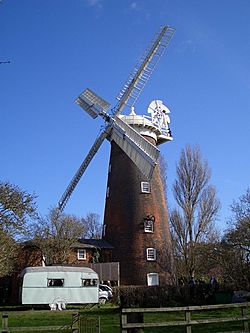Buttrum's Mill, Woodbridge facts for kids
Quick facts for kids Trott's MillButtrum's Mill |
|
|---|---|

The mill in 2006
|
|
| Origin | |
| Mill location | TM 264 493 |
| Coordinates | 52°05′44″N 1°18′16″E / 52.0956°N 1.3045°E |
| Operator(s) | Suffolk County Council |
| Year built | 1836 |
| Information | |
| Purpose | Corn mill |
| Type | Tower mill |
| Storeys | Six storeys |
| No. of sails | Four Sails |
| Type of sails | Patent sails |
| Windshaft | Cast Iron |
| Winding | Fantail |
| Fantail blades | Six Blades |
| Auxiliary power | Portable steam engine |
| No. of pairs of millstones | Four pairs |
| Size of millstones | All 4 feet (1.22 m) diameter |
| Other information | Tallest surviving windmill in Suffolk |
Buttrum's Mill, also known as Trott's Mill, is a historic windmill located in Woodbridge, Suffolk, England. It's a special type of windmill called a tower mill, and it has been carefully fixed up so it can work again. Being 'Grade II* listed' means it's a very important historical building.
Contents
The Mill's Story
Building the Mill
This mill was built in 1836 by John Whitmore, a skilled mill builder from Wickham Market. It took the place of an older, different kind of windmill called a post mill. The Trott family, who had it built, ran the mill for a long time. Later, the Buttrum family took over.
Working Life and Changes
Buttrum's Mill used wind power to grind corn until October 11, 1928. In 1934, parts of the sails, called shutters, were taken off and stored inside the mill. A mill enthusiast named Mr. Kenney bought the mill in 1937.
In the 1940s, a part called the fantail blew off, which damaged the top of the mill, known as the cap. In 1950, East Suffolk County Council took over the mill. Their goal was to save examples of different types of windmills.
Restoring the Mill
From 1952, the damaged mill was restored by Thomas Smithdale and Sons, mill builders from Acle, Norfolk. This work, which cost about £4,000, was finished in 1954. Part of the money came from the Pilgrim Trust.
During this restoration, the metal walkway around the cap was replaced with a wooden one. A new cap and fantail were also built. The fantail was damaged again in a strong wind in December 1966. In 1973, a new main beam (stock) and sail were put on.
More restoration work happened in the late 1970s by Millwrights International Ltd. A new cap was lifted onto the mill with a crane in 1982, and new sails were added in 1984.
How Buttrum's Mill Works
Buttrum's Mill is a tall, six-storey tower mill. It has a special curved cap with a walkway around it. The base of the tower is about 6.2 meters (20 feet 6 inches) wide inside. At the top, where the cap sits, it's about 3.3 meters (11 feet) wide. The mill stands about 14.6 meters (48 feet) high to the top of the tower. The brick walls at the bottom are about 58 centimeters (23 inches) thick.
This mill is the tallest surviving windmill in Suffolk, standing about 18.6 meters (61 feet) to its highest point. A six-bladed fantail turns the cap to face the wind.
Inside the Mill
The mill has four large sails, each about 21.3 meters (70 feet) long. These sails are connected to a strong cast-iron shaft called a windshaft. This shaft also holds a large brake wheel with wooden teeth.
The brake wheel turns a smaller wheel called a wallower, which is on a tall, upright shaft. The wallower can be disconnected if the mill needs to be powered by an engine instead of wind. Lower down, another cast-iron wheel, called a crown wheel, powers other machines.
A large cast-iron wheel, the great spur wheel, turns four pairs of millstones. Each millstone is about 1.2 meters (4 feet) across. These stones grind the corn. Two of the four pairs of millstones are controlled by a special device called a governor, which helps keep the grinding even.
An interesting feature of this mill is a speaking tube that connects the different floors. This allowed workers to talk to each other easily. You might notice that one pair of sails is shorter than the other pair.
Millers Who Worked Here
- George Trott (1836–1846)
- Pierce Trott (1846–1861)
- William Benns (1861–1868)
- John Buttrum (1869–1884)
- Mary Ann Buttrum (1885–1908)
- George Buttrum (1908–1928)
Visiting Buttrum's Mill
As of 2015, Buttrum's Mill was expected to be open for guided tours on the first and third Sundays from May to September, usually from 1 PM to 5 PM. There were also extra openings for special events like Maritime Woodbridge and National Heritage Open Days, run by volunteers.
In 2011, the mill was open during Easter and on Saturdays, Sundays, and Bank Holidays from May to September, from 2 PM to 5:30 PM. It is also open from 11 AM to 5 PM on National Mills Weekend.
Other Mills Nearby

